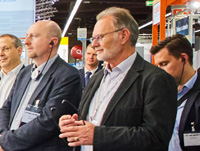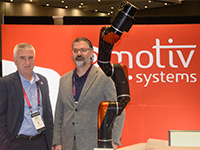
Press Release
The euphoria in the industry was palpable when more than 1100 specialists in space technology gathered in Las Vegas at the end of October for the ASCEND conference of the American Institute of Aeronautics and Astronautics (AIAA): Spaceflight is in the midst of a transformation from government-funded research and national prestige projects into a commercially successful field of business. Both well-established and startup companies in the “New Space” movement continue to gain ground accordingly. And with NASA's new research and exploration goals, industry momentum is accelerating. After all, the space agency's large-scale "back to the moon and then further" projects are expanding the industry's focus from near-Earth orbits to "cislunar" space: the area between geostationary orbit and the orbit of the moon.
The presentations and panel discussions at ASCEND covered the entire field of modern space activities – from deep dive technical presentations to concepts on building a global rescue system for space travelers and even a space police force. After all, some visionaries are already planning space colonies for thousands of people, and there must be the appropriate infrastructure and legal framework to go along with it.
In the thick of technological developments for space is EtherCAT. The ETG’s Executive Director Martin Rostan, an aerospace engineer by education, presented a new paper at the conference titled "Advancing Space Robotics with the EtherCAT Communication Standard". This paper was developed together with Dr. Gerhard Grunwald from the DLR Institute of Robotics and Mechatronics and Chris Thayer, the CEO of Motiv Space Systems.
Chris Thayer commented during the ASCEND conference: "Computing power is a coveted and very expensive commodity in space: only a few space qualified systems can handle the computationally intensive needs of advanced robotics. It helps us enormously that EtherCAT requires hardly any resources from the controller: neither computing power nor special hardware. This makes our space robotics much easier to integrate into other systems."
The DLR Institute was among the first in the industry to recognize that bus systems developed specifically for space applications were too expensive and made them dependent on just a few suppliers. As early as 2004, the DLR selected EtherCAT as the ideal technology for space robotics in a research project and has since relied on this communication standard – which is also the leading network for industrial robots. Now EtherCAT is also establishing itself as the de-facto standard for space robotics. EtherCAT will not only be used in NASA's Lunar Gateway but is already being used in many other high profile space projects. This acceptance radiates into other industries: "What’s good enough for NASA, that’s good enough for me." Martin Rostan has heard this validation many times from ETG members and EtherCAT users.
More than 250 ETG member companies are active in the aerospace and New Space industries.
Picture caption
Martin Rostan (left) and Chris Thayer at the Motiv Space Systems booth, ASCEND conference, Las Vegas, NV

Press Contact
For further public relation information please contact us via: press@ethercat.org
Press Archive
Press Archive 2018
Press Archive 2017
Press Archive 2016
Press Archive 2015
Press Archive 2014
Press Archive 2003-2013

